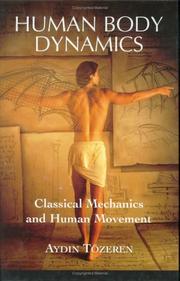| Listing 1 - 1 of 1 |
Sort by
|

ISBN: 9780387988016 0387988017 9780387216911 9786610187317 128018731X 038721691X Year: 2000 Publisher: New York, NY : Springer New York : Imprint: Springer,
Abstract | Keywords | Export | Availability | Bookmark
 Loading...
Loading...Choose an application
- Reference Manager
- EndNote
- RefWorks (Direct export to RefWorks)
“The human body is a machine whose movements are directed by the soul,” wrote René Descartes in the early seventeenth century. The intr- sic mechanisms of this machine gradually became clear through the hard work of Renaissance scientists. Leonardo da Vinci is one such scientist from this period of enlightenment. In pursuit of knowledge, Leonardo dissected the bodies of more than 30 men and women. He sawed the bones lengthwise, to see their internal structure; he sawed the skull, cut through the vertebrae, and showed the spinal cord. In the process, he took extensive notes and made carefully detailed sketches. His drawings d- ferentiated muscles that run across several joints from those muscles that act on a single joint. “Nature has made all the muscles appertaining to the motion of the toes attached to the bone of the leg and not to that of the thigh,” wrote Leonardo in 1504 next to one of his sketches of the lower extremity, “because when the knee joint is flexed, if attached to the bone of the thigh, these muscles would be bound under the knee joint and would not be able to serve the toes. The same occurs in the hand owing to the flexion of the elbow. ” Another Renaissance scholar who made fundamental contributions to the physiology of movement is Giovanni Alfonso Borelli. Born in 1604 in Naples, Borelli was a well-respected mathematician.
Biomechanics --- Movement --- Human mechanics --- Mécanique humaine --- Human mechanics. --- Human physiology. --- Life sciences. --- Medicine. --- Physiological Processes --- Musculoskeletal Physiological Processes --- Physiological Phenomena --- Musculoskeletal Physiological Phenomena --- Musculoskeletal and Neural Physiological Phenomena --- Phenomena and Processes --- Locomotion --- Human Anatomy & Physiology --- Biology --- Health & Biological Sciences --- Physiology --- Biology - General --- Biomedicine. --- Human Physiology. --- Life Sciences, general. --- Biomedicine general. --- Biomedicine, general. --- Biomechanical Phenomena. --- Physiology. --- Health Workforce --- Biosciences --- Sciences, Life --- Science --- Human biology --- Medical sciences --- Human body
| Listing 1 - 1 of 1 |
Sort by
|

 Search
Search Feedback
Feedback About
About Help
Help News
News